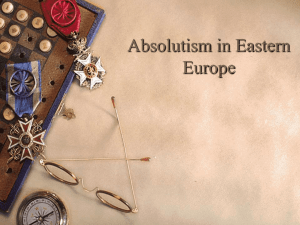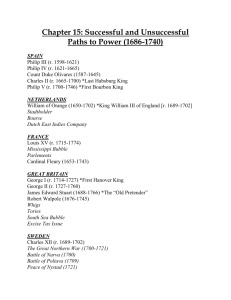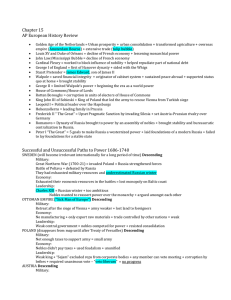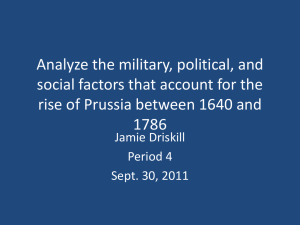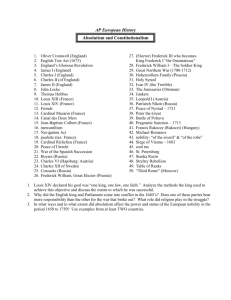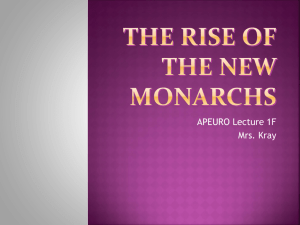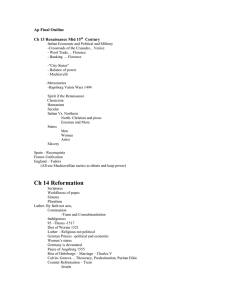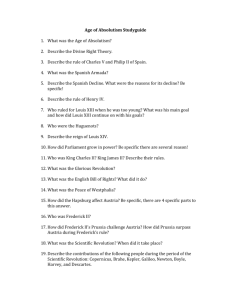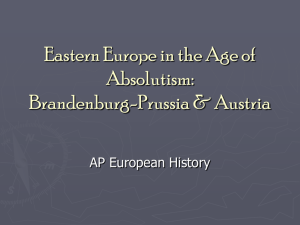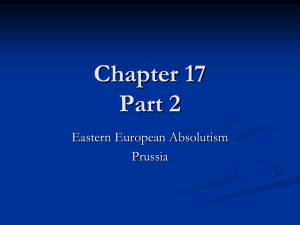Hapsburgs, Hohenzollerns, & Romanovs
advertisement
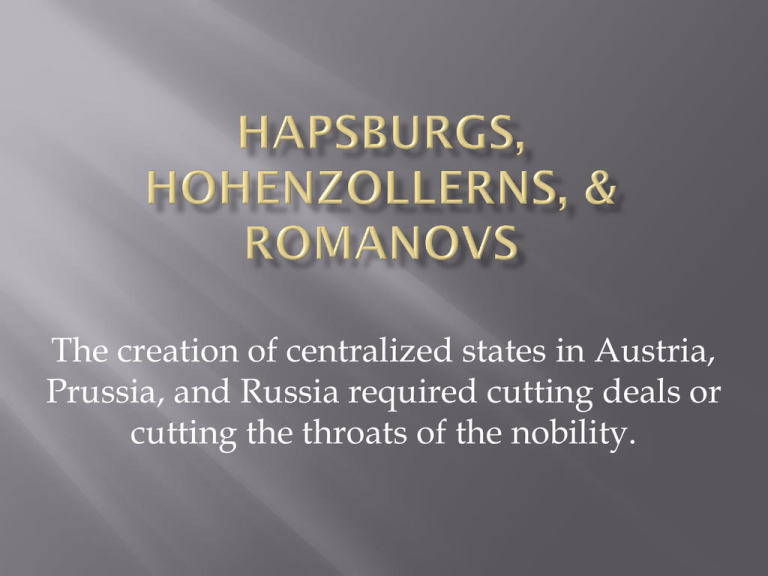
The creation of centralized states in Austria, Prussia, and Russia required cutting deals or cutting the throats of the nobility. Habsburgs Ferdinand III Leopold I Joseph I Charles VI Maria Theresa Pragmatic Sanction Hohenzollern Frederick William, the Great Elector Frederick I Frederick William I Frederick II, the Great Junkers Ivan the Great Ivan the Terrible Time of Troubles Michael Romanov boyars Cossacks Peter the Great streltsy Table of Ranks Great Northern War In all three states, the monarchs granted nobles virtually unrestricted rights over their serfs, thus guaranteeing wealth in exchange for political power Nobles in all three states served as the officer corps of expanding armies. In 1620, Ferdinand III confiscated the lands of Bohemia’s Protestant nobles and distributed to loyal Catholics and mercenaries. In exchange for their loyalty, these new nobles were allowed to forced their serfs to work for up to 7 days a week, this system was called the robot Ferdinand III established a permanent standing army and improved the administration of the state. After the 30 Year’s War, the Habsburgs gave up on maintaining the Holy Roman Empire, instead, turning their attention to expanding their Austrian Kingdom 1683, Leopold I forced the Ottoman Turks to lift their siege of Vienna and pushed them out of Transylvania By the 18th century, the Habsburgs ruled a vast Austrian Empire of many nationalities: Austrians, Germans, Magyars, Belgians, Czechs, Poles, Rumanians, Serbs, Slovenes, and Italians Hungarian nobles retained their privileges, allowing Hungary some autonomy after it was conquered and absorbed into the Austrian Empire. Charles VI, who ruled from 1711 to 1740, secured the Pragmatic Sanction to guarantee Habsburgs possessions for his daughter Maria Theresa Hohenzollern family ruled both Prussia, a agricultural area along the Baltic Sea and Brandenburg, the area around Berlin, where they held the title of Elector of the Holy Roman Emperor In 1618 the two states united to form Brandenburg-Prussia, usually referred to as Prussia During the 30 Year’s War, Prussia was largely a victim, but the war strengthened the monarchy because it eroded the position of the Junkers, as the nobles in Prussia were called Frederick William, the Great Elector, whose 40 year reign began in 1640, forced the Junkers to relinquish their traditional political rights He did not call their representative assembly, the diet, into session at all in the last thirty years of his rule. In return, the Junkers were given greater authority over their serfs The Great Elector’s son was granted the title king of Prussia in 1701 and became Frederick I Frederick I son, Frederick William I, the soldier king, proved to be the ablest of them all. He tripled the size of the army and trained and disciplined the troops to a degree not seen elsewhere, turning the army into the best prepared in Europe He infused militaristic values throughout his kingdom so that hard work, devotion to duty, honesty, and obedience became Prussian ideals Frederick William I turned the Junkers into servants of the state making them the officer class of the new army after threatened to destroy them if they did not submit. Prussia was generally at peace under Frederick William I Frederick William’s I son, Frederick II the Great, would be the one to utilizing the Prussian war machine The dynasty that created a centralized state in Russia were the rulers of Muscovy Ivan III, the Great established a kingdom which reached to the Baltic to Moscow and Novgorod 1480, Ivan the Great refused to acknowledge the Mongol Khan as his ruler, declaring himself the sole authority in Russia The boyars, the Russian nobility, were allowed to keep local power and new titles for the officer corps were created Ivan IV, the Terrible, took the title of Tsar (Caesar) and went to war against the Mongols, defeating them in the 1550s Ivan the Terrible added Mongol lands to his realm, creating the foundation to the modern, multiethnic Russia empire Ivan the Terrible required that all nobles serve the tsar in order to own land. In an effort to consolidate rule he began a reign of terror killing many boyars and giving their lands to service nobles who got their titles in return for loyalty to him and military service. Ivan’s death led to the Times of Troubles (1584 to 1613) when competing claimants to the throne struggle for power Nobles elected Michael Romanov as tsar in 1613 establishing the Romanov dynasty Peter the Great, 1682 to 1725, sought to make Russia a great power through his westernizing reforms Welcomed foreigner talent Established schools and universities Built factors and mines worked by forced labor of serfs Nobles were forced to dress in European style, become educated, shave their beards, and build and live in fancy houses in his new capital, St. Petersburg Five years of education away from home was required for every young nobleman Men and women were allowed to choose their own spouses Unigeniture, inheritance only by the oldest child, was imposed Peter the Great created new rankings for nobles, the Twelve Ranks, rewarding service to the state with higher ranking The gulf between the peasantry and nobles grew All nobles were expected to work their way up the rankings Military service or civil service was for life Some slots were given to middles-class servants of the state Peter’s reign meant higher taxes and greater obligations for serfs Peter defeated the Swedes in 1721 ending the Great Northern and built St. Petersburg on formerly Swedish territory
